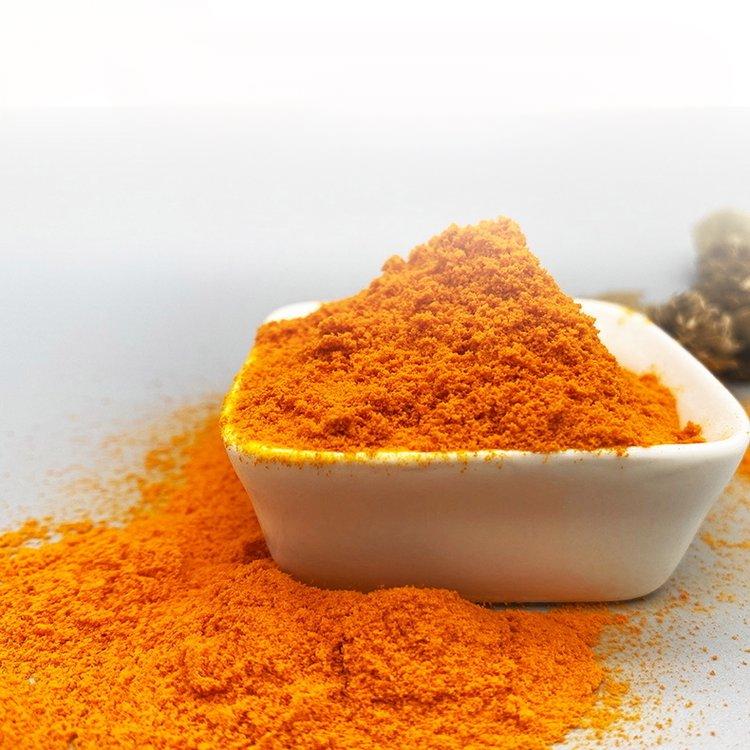Beta Carotene What Is It?
Beta-carotene is one of the more abundant carotenoids in nature. As one of the most stable natural pigments, it is widely found in natural seasonal vegetables and fruits, such as carrots, spinach, broccoli, tomatoes, mangoes, and star fruits. The beta-carotene content of different vegetables and fruits varies, and in general, the darker the color, the richer the content. Since Wacken-roder first extracted β-carotene from carrots in the 1830s, it has been found to have strong antioxidant, cell proliferation and differentiation promoting, intercellular signal transduction regulating, gene expression influencing, immune enhancing, anti-inflammatory, anti-cancer, cardiovascular disease prevention and anti-aging effects.
Beta-carotene is a relatively safe precursor form of vitamin A. There are differences in the metabolism of beta-carotene in different animals. Some studies have shown that there are specific carrier proteins in the intestines and other tissues of different animals that strictly regulate the absorption and accumulation of beta-carotene. The metabolic pathways of different species still need to be explored. In recent years, as research on β-carotene has continued to deepen, the global demand for β-carotene has become increasingly high. Currently, β-carotene has been approved for use as a feed additive for all animals in 52 countries and regions around the world. This article mainly reviews the metabolic pathways and biological activities of β-carotene and its applications, with the aim of providing a reference for the development and utilization of β-carotene and the healthy breeding of animals.
1 Physical and chemical properties of β-carotene
β-Carotene (molecular formula C40H56) is an orange-red to dark red shiny rhombic hexahedron, plate-like microcrystals or crystalline powder with a slight peculiar smell. It has a melting point of 176-184°C, is insoluble in water, propylene glycol and glycerin, slightly soluble in ethanol, methanol and ether, soluble in chloroform, hexane, carbon disulfide, acetone and benzene, unstable in the presence of light and heat, and easily oxidized. The chemical structure of β-carotene is formed by four isoprene double bonds, and there are mainly all-trans, 9-cis, 13-cis and 15-cis. There are four structural formulas: all-trans, 9-cis,cis and 15-cis. In the cis structure, there is a large steric hindrance between the hydrogen atoms near the double bond or between the hydrogen atoms and the methyl group, which makes the cis structure unstable. Therefore, natural β-carotene mainly exists in the all-trans structure (Figure 1).

2 β-Carotene metabolic pathway
In humans and animals, β-carotene is ingested through the diet and enters the intestines through chewing. Under the action of intestinal enzymes, β-carotene is released from food, mainly in the small intestine, and emulsified with ester substances to form chylomicrons, which are absorbed by small intestinal mucosal cells through passive diffusion. The body's absorption of β-carotene from food varies greatly, depending mainly on the β-carotene content of the food, the type of lipids, other carotenoids and vitamin A factors, as well as the animal species.
As a highly lipophilic non-polar molecule, β-carotene mainly exists in the form of a protein complex. The steps involved in the absorption of β-carotene from food by the epithelial cells of the small intestine mucosa of animals are: (1) In the stomach, the action of pepsin and other digestive enzymes releases β-carotene from the protein complex; (2) In the duodenum, the released β-carotene forms chylomicrons with other lipid substances under the emulsifying action of bile. The chylomicrons enter the small intestine and is then absorbed by the small intestinal mucosal epithelial cells; (3) After the β-carotene-containing chylomicrons enter the small intestinal mucosal epithelial cells, they mainly go to three places. One is that β-carotene is converted into β-carotene-15,15-monooxygenase (β,β-carotene 15,15-monooxygenase, BCO Ⅰ) and β-carotene-9,10-dioxygenase (β, β-carotene 9,10-dioxygenase, BCO Ⅱ) is converted into vitamin A. The second is that β-carotene re-enters the intestine with the renewal of mucosal epithelial cells, and then excreted from the body; the third is that β-carotene enters the blood circulation through the portal vein or lymph and is further transported to the liver and other target tissues, and some of it can be converted into vitamin A in the liver, stored or involved in other biological functions of the body.
3 Biological functions of β-carotene and its applications
3.1 Vitamin A precursor
Studies have shown that many carotenoids have vitamin A activity, with β-carotene having the highest activity and thus becoming an important source of vitamin A in animal bodies. As early as the 1930s, Steenkbock discovered that β-carotene may have vitamin A activity. Moore proved experimentally that β-carotene can be converted into vitamin A in animals and exert the function of vitamin A. There are two ways in which beta-carotene is converted to vitamin A: (1) central cleavage (symmetrical cleavage): beta-carotene is converted to two molecules of vitamin A by BCO Ⅰ; (2) eccentric cleavage (asymmetrical cleavage): beta-carotene is converted to one molecule of vitamin A by BCO Ⅱ. Studies have shown that animals cannot synthesize vitamin A directly, and can only obtain it from food or vitamin A sources. When the body lacks vitamin A, the BCO content and activity increase, and it can convert the β-carotene stored in the liver into vitamin A. When the amount of vitamin A in the body reaches the required level, this conversion will immediately stop, and there will be no excessive accumulation of vitamin A. In other words, animals have the ability to maintain the dynamic balance of vitamin A in the body by regulating the activity of BCO.
3.2 Antioxidant function
Under normal conditions, the body is in a state of balance between oxidation and anti-oxidation. This balance is maintained by the antioxidant defense system, which is divided into enzymatic and non-enzymatic systems. The enzymatic system includes superoxide dismutase (SOD), catalase (CAT), glutathione peroxidase (GSH-Px), etc., and the non-enzymatic system includes reduced glutathione (GSH), vitamin C, vitamin E and some natural antioxidants. Reactive oxygen species (ROS) in the body are by-products formed during normal cell metabolism. Low levels of ROS play a vital role as signalling molecules in many signal transduction pathways in the body. However, when the body is subjected to adverse stimuli, the production of ROS increases. The body's antioxidant defence system cannot remove them in time, and this balance is disrupted, which in turn damages the body.
ROS mainly include superoxide anion (O2-), hydrogen peroxide (H2O2), hydroxyl radical (OH-), ozone (O3) and singlet oxygen (1O2). Beta-carotene contains a special molecular structure of polyenes, so it has a strong free radical trapping ability, can remove ROS, and significantly improve the body's antioxidant status. Research data shows that one molecule of β-carotene can inhibit 1000 molecules of 1O2. At present, β-carotene reacts with ROS mainly through three pathways: one is the electron transfer mechanism, the second is the hydrogen atom transfer mechanism, and the third is the free radical addition reaction. Some scholars have found that β-carotene can activate the NF-E2-related factor 2 (Nrf2) - Kelch-like ECH-associated protein 1 (Keap1) - antioxidant response element (ARE) signaling pathway to upregulate the expression of antioxidant enzyme genes, thereby enhancing the body's ability to clear free radicals with antioxidant enzymes. Keap1) - The antioxidant response element (antioxidant response element, ARE) signal pathway upregulates the expression of antioxidant enzyme genes, thereby enhancing the body's ability to scavenge free radicals with antioxidant enzymes.
Szczubia found that the levels of GSH-Px, CAT and SOD in the blood erythrocytes of pregnant sows were significantly elevated after intramuscular injection of β-carotene in the late stage of pregnancy. Salem found that the level of GSH-Px was significantly increased and the content of malondialdehyde (MDA) was significantly reduced after mice were supplemented with β-carotene. Studies have found that adding an appropriate amount of beta-carotene to the diets of dairy cows and beef cattle can significantly increase the levels of GSH-Px, CAT and SOD in the serum, while significantly reducing the level of MDA. Akcakaya et al. used H2O2 peroxide to subject K562 cells to an oxidative stress test and found that β-carotene had no effect on improving the oxidative damage to cells when it was treated at the same time as H2O2 or after treatment, but pre-treatment with β-carotene significantly improved the oxidative damage to cells caused by H2O2.
3.3 Enhancing animal immunity
Beta-carotene enhances the body's resistance to certain diseases and improves animal health by boosting cellular, humoral and non-specific immune responses. The research results of Zhang Xiaoyin and others show that β-carotene can significantly improve the cell viability of macrophages RAW264.7 stimulated by lipopolysaccharide (LPS). Ma et al. found that feeding mice β-carotene after cyclophosphamide (CTX) administration can improve the damage to immune organs caused by CTX and increase the levels of cytokines and immunoglobulins in mouse serum. Ji Yubin and others showed that CTX) and then supplemented with β-carotene can improve the damage to the immune organs caused by CTX-induced immunosuppression in mice and increase the levels of cytokines and immunoglobulins in mouse serum. Ji Yubin et al. showed that adding different doses of β-carotene to the diet of one-day-old Hy-Line brown chickens can significantly increase the content of immunoglobulin A (IgA) in the blood of chicks.
Meanwhile, Lo et al. found that β-carotene can improve the body's immune function by regulating the secretion of granulocytemacrophage-colony stimulating factor (GM-CSF), interleukin-6 (IL-6), and matrix metalloproteinase-9 (MMP-9). thereby enhancing the body's immune capacity. Maho et al. found that feeding Japanese black cattle beta-carotene significantly increased the immunoglobulin G (IgG) content of colostrum. Liu Haiyan et al. added different doses of beta-carotene to the diets of 21-day-old Hy-Line brown chickens and found that beta-carotene significantly improved the immune organ index of the chickens. Li Yanqiang found that adding β-carotene to the basal diet of pregnant sows can improve the immune capacity of newborn piglets, increase the health rate and weaning weight of piglets, and significantly reduce the mortality rate of piglets from birth to weaning.
3.4 Improve animal reproductive capacity
In animals, beta-carotene can protect the uterus, ovaries and active reproductive cells from damage caused by oxidative reactions, thereby protecting important cell organs of the reproductive system and thus enhancing animal fertility and improving production performance. Beta-carotene can also stimulate the production of progesterone and is related to the synthesis of estrogen and progesterone and enhances their activity.
Relevant literature reports that in production practice, after adding β-carotene to the diet of dairy cows, the incidence of retained afterbirth after calving decreased by 15%, the incidence of mastitis decreased by 17%, and the conception rate within 90 days after calving increased by 14%. Ma Jifeng et al. found that adding 100, 200, or 300 mg/kg β-carotene to the basic diet of dairy cows can improve their reproductive performance and reduce the somatic cell count in milk compared to the control group without added β-carotene.
Li Ziyan added different doses of β-carotene (0, 200, 400 mg/head·d) to the dairy cow diet. The results showed that adding 400 mg/head·d β-carotene to dairy cows after calving can significantly reduce the number of mating times, shorten the time from the first estrus after calving to the first mating, reduce the number of days of non-breeding, increase the conception rate during the heat period, and significantly reduce the occurrence of postpartum reproductive diseases; adding β-carotene to the diet has a tendency to increase serum progesterone and significantly increase the content of luteinizing hormone and estrogen. Liu Ruigang et al. also showed that adding microencapsulated β-carotene to the diet of sows in the late stages of pregnancy significantly increased the serum estradiol and progesterone levels in the sows. The possible mechanism is that β-carotene, as an antioxidant, plays an important role in protecting follicular cells and the production of steroid hormones in the endometrium. Arellano-Rodriguez et al. found that short-term supplementation with β-carotene can increase ovulation rate in goats and enhance the synthesis and secretion of progesterone by corpus luteum tissue.

3.5 Improve the quality of livestock products
The special conjugated double bond structure in the β-carotene molecule determines its own color through its light absorption properties, and it also has good coloring properties. Zhang Hui et al. found that adding β-carotene to broiler feed can improve the meat color and leg coloring of broilers. Li Junying et al. showed that adding β-carotene to a corn-soybean meal diet significantly improved the color of the egg yolk. Li Xiong et al. also found that adding β-carotene to the diet of hens at peak egg production significantly improved the color of the egg yolk and improved egg quality. In addition, β-carotene has a significant regulatory effect on fat metabolism.
Jin et al. showed that β-carotene can inhibit fat deposition in beef cattle by inhibiting fat synthesis and enhancing fat hydrolysis. Some researchers have also shown that feeding too much β-carotene to beef cattle during the fattening period significantly increases the yellowish color of their meat and reduces the grade of the beef, so it is advisable to supplement an appropriate amount of β-carotene to beef cattle during the fattening period. Yuan Dezhi et al. confirmed through experiments that adding Research has shown that adding 30 mg/kg of beta-carotene to the basic diet of fattening pigs can improve the pH and color of the pork after slaughter and reduce the production of inferior meat. The mechanism may be that beta-carotene reduces lipid oxidation of cell membranes and reduces the exudation of intracellular fluid. Jin Qing et al. added 0, 600, 1200, and 1800 mg/d of β-carotene to the basic diet of beef cattle and found that the addition of β-carotene to the diet can significantly increase the β-carotene level in the liver of beef cattle, and the slaughter rate and net meat rate increase significantly with the increase of the amount added. Wu Hongjiu and Xia Yun's research both showed that adding β-carotene to the diet of dairy cows can significantly improve milk quality.
3.6 Anti-inflammatory function
Li et al. showed that β-carotene can inhibit the nuclear factor κB (nuclear factor κ-B, NF-κB), Janus kinase 2 (JAK2)/signal transducer and activator of transcription (STAT3) and c-Jun N-terminal kinase (JNK)/p38 mitogen-activated protein kinase (MAPK) signaling pathways to reduce LPS-induced inflammation. Cho et al. found that β-carotene JNK)/p38 mitogen-activated protein kinase (MAPK) signaling pathway to reduce LPS-induced inflammation. Cho et al. found that β-carotene suppresses oxidative stress-induced inflammation by inhibiting the pro-inflammatory adipokine monocyte chemoattractant protein-1 (MCP-1) and regulating the expression and secretion of activated T cells, as well as by enhancing adiponectin in adipocytes. β-Carotene pretreatment of porcine jejunal epithelial cells ( MCP-1) and regulating the expression and secretion of activated T cells, as well as enhancing adiponectin in adipocytes to inhibit inflammation induced by oxidative stress. Pretreatment of porcine jejunal epithelial cells (IPEC-J2) with β-carotene can reduce LPS-induced inflammatory damage to IPEC-J2.
Studies have shown that β-carotene can inhibit the expression and mediation of pro-inflammatory cytokine genes, and inhibit LPS-induced inflammatory responses by inhibiting the degradation of the inhibitor of NF-κB (inhibitor of NF-κB, IκB) and thereby inhibiting NF-κB activation. Beta-carotene can reduce the intestinal inflammatory damage caused by weaning, promote the growth of weaned piglets, and improve intestinal morphology. The possible mechanism is that β-carotene relieves intestinal inflammatory damage in piglets by downregulating the level of NF-κB, a protein in the inflammatory-related signaling pathway. In addition to inhibiting the NF-κB pathway, β-carotene can also relieve inflammation by inhibiting activator protein-1 (AP-1) and the MAPKs signaling pathway. Studies have found that beta-carotene can prevent and alleviate inflammation and its complications by inhibiting pro-inflammatory factors and regulating the expression and secretion of normal T cells, as well as inhibiting the activation of transcription factors.

3.7 Other functions
Studies have found that β-carotene can enhance cell-to-cell communication, reduce damage to the intestines caused by external stress, and thus inhibit or reduce the occurrence of diseases. Studies have shown that β-carotene pretreatment can significantly enhance the viability and transmembrane resistance of LPS-stressed IPEC-J2 cells, relieve the acute phase response caused by high doses of dimethylnitrosamine. Nano-sized titanium dioxide induces damage to the germ cells of mice testes, significantly increasing the height of the duodenum and jejunum villi in Hy-Line brown laying hens. At the same time, β-carotene is an apoptosis agent for cancer cells and has no negative effect on normal cells. Park et al. found that β-carotene can induce apoptosis in gastric cancer cells. Zhou Tong et al. found that β-carotene can reduce the damage to learning and memory caused by obstructive sleep apnea syndrome, and speculate that the mechanism is to inhibit caspase-3, which is closely related to the expression of phosphorylated tau (p-tau) protein.
4 Summary
In summary, research on β-carotene has a history of nearly 200 years. It plays an undeniable role in animal production and has laid a certain foundation for the green, efficient and healthy development of the livestock industry. On the one hand, natural β-carotene (with multiple isomers coexisting) is relatively expensive, and chemically synthesized β-carotene (all trans) has certain toxic side effects on the body under certain conditions; in addition, the large demand for natural β-carotene in the food, cosmetics, and pharmaceutical industries has hindered its widespread use in animal husbandry to some extent. Therefore, further exploration is needed for the industrial production of β-carotene isomers. On the other hand, due to the differences in the metabolism and absorption of β-carotene by different animals, the appropriate amount to be added in animal production and the specific biological functions and metabolic mechanisms are not yet fully understood and still require further in-depth exploration.


 English
English French
French Spanish
Spanish Russian
Russian Korean
Korean Japanese
Japanese


